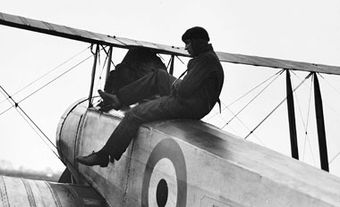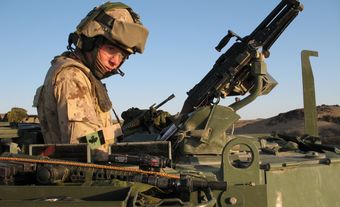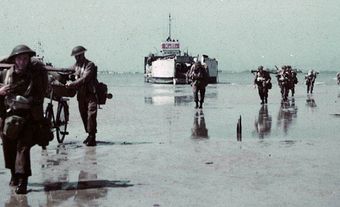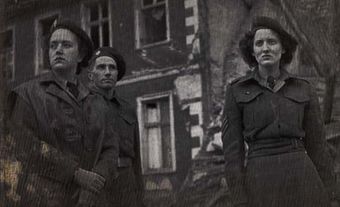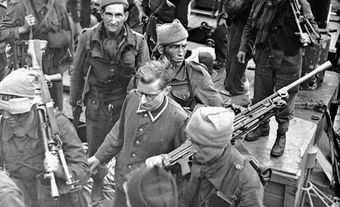James Francis “Stocky” Edwards, CM, fighter and fighter-bomber pilot, ace (born 5 June 1921 in Nokomis, SK; died 14 May 2022 in Comox, BC). Edwards was credited with shooting down 19 enemy aircraft and another 7 “probables” during the Second World War. He also destroyed 12 aircraft and about 200 vehicles on the ground. His actual total was likely higher, as Edwards was unconcerned with claiming victories. He fought in the North African, Italian and North-West Europe campaigns — a rare record for an Allied pilot. Until his death, Edwards was likely the top surviving fighter pilot in the Commonwealth.

Early Life and Education
James Francis Edwards was born into a prairie family of four boys and two girls. When his parents lost their home during the Great Depression, the family moved to nearby Battleford so that his father could get a job. Edwards worked on his uncle’s farm and also hunted wildfowl. With twenty-twenty vision, he became an expert shot and learned how to lead his target rather than shoot directly at it. Edwards used this technique to good effect later as a fighter pilot.
Edwards excelled at playing hockey at St. Thomas College in North Battleford. When he graduated in 1940, he was offered a scholarship to Gonzaga University in Spokane, Washington, and a chance to try out for the Chicago Blackhawks. He gave up these opportunities to join the Royal Canadian Air Force (RCAF).
Second World War
James Francis Edwards enrolled in the RCAF in June 1940 and completed initial flight training in early 1941. In July, he was posted to an operational training unit in England to become a fighter pilot. In January 1942, Edwards was promoted to flight sergeant and assigned to No. 94 Squadron Royal Air Force (RAF) in Egypt, which flew American Curtiss Kittyhawk fighters. His first mission was to escort Boston bombers to the German airfield at Martuba, Libya, on 23 March. He scored his first victory that day when he shot down a Messerschmitt Bf 109.
Did You Know?
The Curtiss Kittyhawk I was an American single-engine, single-seat fighter and fighter-bomber aircraft that served in 28 Allied air forces on several battlefronts. Although some German and Italian fighters outmatched its performance, it was important in the early years of the war because it was tough, reliable and available in large numbers.

Because No. 94 Squadron had suffered heavy losses, it was withdrawn from operations in May 1942 and Edwards was transferred to No. 260 Squadron. He damaged an Bf 109 on his first mission and destroyed another on his second mission. Edwards was promoted through the two warrant officer ranks that summer, and in August he was commissioned as a pilot officer. Shortly afterward, Edwards destroyed six more aircraft over enemy territory. In December, he was promoted to flying officer, with simultaneous promotion to flight lieutenant. Edwards and his fellow pilots later flew in support of Field Marshal Bernard Montgomery’s 8th Army as it pushed Field Marshal Erwin Rommel’s Afrika Korps back across the Western Desert from Egypt to Tunisia and out of North Africa.
In February 1944, Edwards provided air support for the Allied landings at Anzio, Italy. Flying Spitfires, he shot down at least three German fighter planes. Edwards was promoted to squadron leader in March and took command of No. 274 Squadron. He was then sent to England to fly in support of the D-Day landings on 6 June 1944. In April 1945, Edwards was promoted to wing commander and took command of No. 127 Wing RCAF, which consisted of four Spitfire squadrons. In the closing days of the war, he damaged three more aircraft in Germany. In total, Edwards flew 373 combat missions and was Canada’s highest-scoring Western Desert ace.
Edwards was known as “Eddie” during the war and only became known as “Stocky” much later in honour of his fortitude. He received this nickname during training, even though he was skinny as a young man and described by some fellow flyers as a “wiry bantam weight.”

Post-war
Edwards remained in the RCAF after the war and, like several others, took a reduction in rank, in his case to flight lieutenant. He married Norma Hatcher in 1946 and they had two daughters. Norma died of polio shortly afterward. Edwards married Alice “Toni” Antonio in 1951 and they had a daughter and a son. During his post-war career, Edwards flew several types of jets — Vampires, Sabres (F-86) and Canucks (CF-100) — in Canada and overseas. In 1951, Edwards commanded No. 430 Squadron in North Bay, Ontario — the first RCAF F-86 Sabre squadron. A year later, he was promoted to wing commander (for the second time) and posted to France, where he commanded 2 RCAF Wing, made up of a squadron of Sabre jets.
In 1955, Edwards returned to Canada, attended staff college and was posted to American and Canadian air defence positions. In 1966, he returned to Colorado Springs, Colorado, as a plans officer for North American Aerospace (Air at the time) Defense Command ( NORAD). His last posting was as commanding officer of the radar station at Baldy Hughes, British Columbia. Edwards stayed in the armed forces through unification in 1968 and retired in 1972 as a lieutenant colonel (wing commander in pre-unification terms) with the Canadian Forces. During his retirement in Comox on Vancouver Island, his passion was wetlands preservation.
Honours and Awards
- Distinguished Flying Medal (1943)
- Distinguished Flying Cross (1943) and Bar (1944)
- Second World War Campaign and Service Medals:
- 1939–1945 Star
- Africa Star with North Africa 1942–43 Clasp
- Italy Star
- France and Germany Star
- Defence Medal
- Canadian Volunteer Service Medal 1939-1945 with Overseas Clasp
- 1939-1945 War Medal with bronze oak leaf (signifying Mention in Dispatches)
- Canadian Forces’ Decoration (1952) and 1st Clasp (1962)
- Member of the Order of Canada (2004)
- Named “One of the 100 Most Influential Canadians in Aviation” (2009)
- Queen Elizabeth II Diamond Jubilee Medal (2012)
- Canada’s Aviation Hall of Fame (2013)
- Chevalier de l’Ordre National de la Legion d’Honneur (2014)
- Minister of Veterans Affairs Commendation (2014)

 Share on Facebook
Share on Facebook Share on X
Share on X Share by Email
Share by Email Share on Google Classroom
Share on Google Classroom

